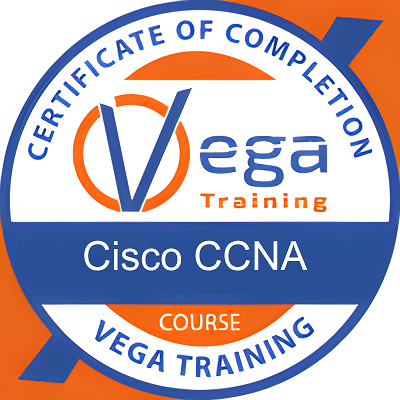Cisco CCNA Course

Badge awarded to
Loris Pasquini
Issued on 18 Oct 2025 by

Vega Training
Issuer

Vega Training
contatti@vegatraining.eu
Impegnata nel settore della alta specializzazione informatica sin dal 2002, e grazie alla pluriennale esperienza maturata nel campo della consulenza informatica aziendale, Vega Training offre un’ampia gamma di corsi, capace di soddisfare richieste formative nell’ambito della Sistemistica, del Networking, dell’Amministrazione Server, della Cyber security, della Virtualizzazione, dei Container, dell’Open Source, dell’IoT, del Cloud, dei Big Data, dell’Intelligenza Artificiale, dei Linguaggi di Programmazione, Database e DevOps.
Engaged in the sector of high IT specialization since 2002, and thanks to the many years of experience gained in the field of business IT consultancy, Vega Training offers a wide range of courses, capable of satisfying training requests in the fields of Systems, Networking, Server Administration, Cyber security, Virtualization, Containers, Open Source, IoT, Cloud, Big Data, Artificial Intelligence, Programming Languages, Database and DevOps.
Criteria
The Badge earner has attended and completed Cisco CCNA Course demonstrating that he has achieved results in the following areas:
- Main trends that take advantage of Networking technologies
- Main features of the Cisco IOS operating system
- Basic configurations of Cisco IOS through Command Line Interface (CLI)
- Role of protocols and standards in the development of network technologies
- Interpretation of Request for Comments (RFC)
- Description of the ISO / OSI model and of the TCP / IP
- Comment on the importance of the Level approach
- Describe the main functions of the levels of the Protocol stack
- Describe the most important protocols of the Application Level
- Http, Https, FTP, Smtp, Pop3, IMAP, Radius, Telnet, TFTP, DNS, etc
- Role of the Transport Level and in-depth analysis of the functioning of TCP and UDP
- Analysis of the fields present in the Segment header
- Introduction to the Wireshark Network Analyzer
- Role of the Network level and in-depth analysis of IPV4 addressing
- Analysis of the fields in the package header
- Types of Unicast, Broadcast and Multicast traffic
- Planning of addressing and Subnetting VLSM
- First concepts of routing and implementation of static routes in different topologies
- IPV6 protocol differences and deepening of the dynamics of operation
- IPV6 static routing applied to different topologies
- Troubleshooting tools, ICMP and Traceroute
- Maintenance and Backup Management of Cisco Router and Switch devices
- In-depth analysis of Cisco IOS Packaging and Licensing
- Role of the Data-link layer in Lan and Wan contexts
- Deepening of the Ethernet protocol
- Analysis of the fields present in the header of the Frame
- Switching, Mac Address, MAC Table, Store and forward cut through technologies
- Basic Configurations of Cisco Switches
- ARP protocol
- Types of Transmission Media (UTP, STP, Fiber, Wireless)
- Cisco Discovery Protocol CDP protocol
- LLDP Link Layer Discovery Protocol
- NTP Network Time Protocol
- Notes on the fundamental elements of IT security
- Analysis of the various types of routes available in a router
- Structure of the IPV4 and IPV6 routing table
- Deepening of the decision-making mechanisms of the router
- Concept of Metrics and Administrative Distance
- Fully Specified IPV4 and IPV6 Static Routes
- IPV4 and IPV6 Floating Static Routes
- Routing Lookup Process and difference between RIB and FIB
- Introduction to IP CEF and forwarding technologies
- Summarization techniques
- Introduction to dynamic routing
- Distance-Vector and Link-State routing protocols
- RIP v1 protocol
- RIP v2 and RIPng protocol
- Classfull protocols Vs Classless protocols
- EIGRP IPV4 and IPV6 protocol
- Diffusing Update Algorithm (DUAL)
- Advanced Functions and EIGRP Tuning
- Auto Summarization and Manual Summarization
- OSPF and OSPFv3 protocol
- Shortest Path First (SPF) algorithm
- OSPF tuning
- OSPF MultiArea: Summarization Inter-Area
- BGP Border Gateway Protocol
- Introduction of Access Control List (ACL) IPV4 and IPV6
- standard and extended ACLs
- ACL numbered and named
- Regulate remote management via ACL
- ACL management and troubleshooting
- Network Address Translation
- NAT Statica Static address translation
- Dynamic NAT Dynamic address translation
- Port Address Translation (PAT) NAT overloading
- Port Forwarding
- NAT64 (hints)
- Level 2 hierarchical network (Core-Distribution-Access level)
- How a switch routes frames. Mac-address table
- Collision domains and broadcast domains
- Basic configuration of a switch
- Port-security
- Introduction to VLANs (role of VLANs in a switched network)
- Configure VLANs and trunks
- Inter-VLAN Routing
- VTP protocol
- VLAN Trunk Protocol configuration
- Introduction DTP
- Dynamic Trunking Protocol
- On a stick inter-vlan routing router configuration
- Multi-layer switch
- Troubleshooting inter-vlan routing
- Role of the spanning-tree in a switched network with redundancy
- STP algorithm: switch roles, port roles
- PVST + and Rapid PVST +: similarities and differences
- PVST + and Rapid PVST + configuration
- Link Aggregation in a switched network
- Link aggregation configuration with Etherchannel
- Description of the FHRP protocols
- HSRP Configuration and Troubleshooting
- DHCPv4 implementation in a business network
- Configuring a router as a DHCPv4 server and as a DHCPv4 client
- DHCPv6 implementation in a business network
- DHCPv6 configuration
- WIRELESS LAN networks: structure of a wireless LAN network
- Securing a wireless LAN network
- Setting up a wireless router
- Cisco Switch Port Analyzer (SPAN)
- Introduction to WAN networks, differences between LAN and WAN
- Description of WAN technologies
- Select WAN technologies based on your company's requirements
- Difference between public WAN and private WAN
- HDLC configuration over a serial link
- PPP protocol over a point-to-point serial link
- PPP configuration
- PPP authentication configuration (PAP and CHAP)
- Troubleshooting PPP
- Introduction and PPPoE Configuration
- Frame-Relay: how it operates in a business network
- Frame-Relay configuration
- Point-to-point subinterface configuration
- Troubleshooting Frame-Relay
- Introduction of VPN Technologies (SSL and IPsec)
- DMVPN Dynamic Multipoint VPN
- eBGP iBGP
- QOS introduction
- Quality of Service configuration
- Introduction Syslog, SNMP and NetFlow and SNMPV3
- Introductions to Programmable Networks
- Software Defined Network
- Cisco ACI (Cisco Application Centric Infrastructure)
- Cisco DNA and WLC
- Power Over Ethernet (PoE)
- Wi-Fi, SSID, RF and Encryption channels
- Wireless architecture components (AP, WLC, access, trunk, LAG)
- Access Point and WLC management through the main protocols (ssh, https, TACACS +, RADIUS)
- Implement Qos and advanced WLAN settings
- Wireless security (WPA, WPA2, WPA3)
- AAA in the Wireless sector
- Level 2 security (DHCP snooping, dynamic ARP inspection, and port security)
- Comparison between traditional networks (Legacy) and controller-based networks (SDN)
- Components of the SDN paradigm (overlay, underlay, fabric, control plane, data plane
- North-bound and South-bound APIs
- Device management through Cisco DNA
- REST-based APIs (CRUD, HTTP verbs, data encoding)
- Puppet, Chef, Ansible
- JSON encoded
Lab Activities
- Get Started with Cisco Command- Line Interface (CLI)
- Observe How a Switch Operates
- Perform Basic Switch Configuration
- Implement the Initial Switch Configuration
- Inspect TCP/IP Applications
- Configure an Interface on a Cisco Router
- Configure and Verify Layer 2 Discovery Protocols
- Implement an Initial Router Configuration
- Configure Default Gateway
- Explore Packet Forwarding
- Troubleshoot Switch Media and Port Issues
- Troubleshoot Port Duplex Issues
- Configure Basic IPv6 Connectivity
- Configure and Verify IPv4 Static Routes
- Configure IPv6 Static Routes
- Implement IPv4 Static Routing
- Implement IPv6 Static Routing
- Configure VLAN and Trunk
- Troubleshoot VLANs and Trunk
- Configure a Router on a Stick
- Implement Multiple VLANs and Basic Routing Between the VLANs
- Configure and Verify Single- Area OSPF
- Configure and Verify EtherChannel
- Improve Redundant Switched Topologies with EtherChannel
- Configure and Verify IPv4 ACLs
- Implement Numbered and Named IPv4 ACLs
- Configure a Provider- Assigned IPv4 Address
- Configure Static NAT
- Configure Dynamic NAT and Port Address Translation (PAT)
- Implement PAT
- Log into the WLC
- Monitor the WLC
- Configure a Dynamic (VLAN) Interface
- Configure a DHCP Scope
- Configure a WLAN
- Define a Remote Access Dial- In User Service (RADIUS) Server
- Explore Management Options
- Explore the Cisco DNA™ Center
- Configure and Verify NTP
- Configure System Message Logging
- Create the Cisco IOS Image Backup
- Upgrade Cisco IOS Image
- Configure WLAN Using Wi- Fi Protected Access 2 (WPA2) Pre- shared Key (PSK) Using the GUI
- Secure Console and Remote Access
- Enable and Limit Remote Access Connectivity
- Secure Device Administrative Access
- Configure and Verify Port Security
- Implement Device Hardening
Alignments
Catalogo Formativo
https://www.vegatraining.eu/categorie-corsi/
Vega Training - Catalogo Formativo Vega Training - Training Catalog
Cisco CCNA Course
https://www.vegatraining.eu/corsi-cisco/corso-cisco-ccna/
Scheda Corso - Course Sheet

